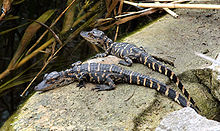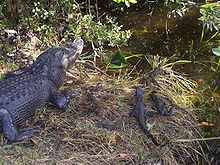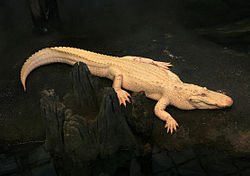- American alligator
-
American Alligator 
An American Alligator in captivity at the Columbus Zoo, in Powell, Ohio Conservation status Scientific classification Kingdom: Animalia Phylum: Chordata Class: Reptilia (unranked): Archosauria Order: Crocodilia Family: Alligatoridae Genus: Alligator Species: A. mississippiensis Binomial name Alligator mississippiensis
(Daudin, 1802)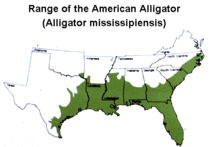
American Alligator range map Synonyms Crocodilus mississipiensis [sic] Daudin, 1802
Alligator mississippiensis Holbrook, 1842The American alligator (Alligator mississippiensis), sometimes referred to colloquially as a gator, is a reptile endemic only to the Southeastern United States. It is one of the two living species of alligator, in the genus Alligator, within the family Alligatoridae. It is larger than the other extant alligator species, the Chinese alligator.
The American alligator inhabits wetlands that frequently overlap with human-populated areas.
Contents
Description
The American alligator has a large, slightly rounded body, with thick limbs, a broad head, and a very powerful tail. Adult Alligators generally have dark gray or nearly black color. They may at times appear to be lighter based on detritus or algae in the water covering their skin. Juvenile alligators have a striped pattern for camouflage that they lose as they mature. Averaging about 9.5 in (24 cm) in length when newly hatched, alligators reach sexual maturity when they measure about 5–7 ft (1.5–2.1 m).[2] Adult male alligators average 11.2 ft (3.4 m) in length, while adult females average 8.2 to 9.8 ft (2.5 to 3.0 m).[3][4][5][6] Average body weights are reported from 270 to 800 lb (120 to 360 kg), with a few exceptionally large and old males exceeding 14 ft (4.3 m) and 1,000 pounds (450 kg).[7][8][9] One American Alligator reached a length of 19 feet 2 inches (5.84 m) and 2,200 lb (1,000 kg),[10] which made it not only the largest alligator ever recorded, but also among the largest crocodilians on record (although the related Black Caiman and 5 other crocodilians are believed to equal or exceed this size and prehistoric crocodilians such as Sarcosuchus, Deinosuchus, and Purussaurus reached much greater size). The tail, which accounts for half of the alligator's total length, is primarily used for aquatic propulsion. The tail can also be used as a weapon of defense when an alligator feels threatened. Alligators travel very quickly in water and while they are generally slow-moving on land, alligators can lunge short distances very quickly. They have five claws on each front foot and four on each rear foot. American Alligators have the strongest laboratory measured bite of any living animal, measured at up to 9,452 newtons (2,125 lbf) in laboratory conditions. It should be noted that this experiment has not (at the time of the paper published) been replicated in any other crocodilians.[11]
Some alligators are missing an inhibited gene for melanin, which makes them albino. These alligators are extremely rare and almost impossible to find in the wild. They could survive only in captivity. Like all albino animals, they are very vulnerable to the sun and predators.[12] American Alligators can remain underwater for several hours if not actively swimming or hunting (then it is only about 20 minutes); they do this by rerouting blood to reduce circulation to the lungs, and thus the need for oxygen.
Habitat
American alligators are mostly found in the Southeastern United States, from Great Dismal Swamp in North Carolina south to Everglades National Park in Florida and west to the southern tip of Texas. They are found in the U.S. states of North Carolina, South Carolina, Georgia, Florida, Louisiana, Alabama, Mississippi, Arkansas, Texas, and Oklahoma. Florida and Louisiana currently have the largest population of alligators. Florida has an estimated population of 1 to 1.5 million while Louisiana has an estimated population of 1.5 million
Although primarily freshwater animals, alligators will occasionally venture into brackish water.[13] Alligators live in wetlands and this is the vital habitat that holds the key to their continued long-term survival. Alligators depend on the wetlands, and in some ways the wetlands depend on them. As apex predators, they help control the population of rodents and other animals that might overtax the marshland vegetation.
American alligators are less prone to cold than American crocodiles. Unlike the American crocodile, which would immediately succumb to the cold and drown in water of 45 °F (7.2 °C), an alligator can survive in such temperatures for some time without any signs of evident discomfort.[14] It is thought that this adaptiveness is the reason why American alligators spread farther north than the American crocodile.[14] In fact, the American alligator is found farther from the equator and is more equipped to deal with cooler conditions than any other crocodilian.[15]
In Florida, alligators face ambient temperature patterns unlike elsewhere in their range. The consistently high temperatures lead to increased metabolic cost. Alligators in the Everglades have reduced length to weight ratio, reduced total length, and delayed onset of sexual maturity compared with other parts of their range. The reason for this poor condition is currently suspected to be a combination of low food availability and sustained high temperatures.
Diet
 Alligators are apex predators capable of killing large terrestrial prey. This large American alligator has caught an adult deer.
Alligators are apex predators capable of killing large terrestrial prey. This large American alligator has caught an adult deer.
Alligators eat fish, birds, turtles, snakes, mammals, and amphibians. Hatchlings diet on invertebrates, insects, larvae, snails, spiders, worms, and other small prey. They will also eat small fish at any opportunity. As they grow, they gradually move on to larger fish, mollusks, frogs and small mammals like rats, and mice. Some adult alligators take a larger variety of prey ranging from a snake or turtle to a bird and moderate sized mammals like a raccoon or deer.
Once an alligator reaches adulthood, any animal living in the water or coming to the water to drink is potential prey. Adult alligators will eat wild boars, deer, dogs of all sizes, livestock including cattle and sheep, and are often known to kill and eat smaller alligators. In rare instances, large male alligators have been known to prey on the Florida panther and American black bear, making the American alligator the apex predator throughout its distribution.[16] The American alligator is known as King of the Everglades, although the American crocodile, which shares parts of the Everglades with the alligator, is capable of growing larger (over 5 meters), mostly in warmer regions like Central America, Mexico, and the Caribbean.
Although fish and other prey taken in the water or at the water edge form the major part of alligator's diet, adult alligators also spend considerable time hunting on land, up to 50 m (170 feet) from water, ambushing terrestrial animals on trailsides and road shoulders on warm nights.[17]
The gizzards (stomachs) of alligators often contain gastroliths. The function of these stones is to grind up food in the stomach and help with digestion. This is important because gators swallow their food whole. These gastroliths are also used in buoyancy control.
In 2005, the bite force of a 12-foot (3.7 m), 450-pound (200 kg) alligator was measured to be 2209 pounds-force (9.826 kN). It was measured by Greg Ericson.[18] American alligators cruise through water at just over 1 mph (0.4 m/s); in pursuit of prey they can swim much faster over short distances.
Reproduction
The breeding season begins in the spring. Although alligators have no vocal cords, males bellow loudly to attract mates and warn off other males during this time by sucking air into their lungs and blowing it out in intermittent, deep-toned roars. Male alligators are also known to use infrasound during their mating behavior, as one of their routines is to engage in bellowing in infrasound while their head and tail are above the water, with their midsection very slightly submerged, making the surface of the water that is directly over their back literally "sprinkle" from their infrasound bellowing, in a so-called "water dance".[19] Recently it was discovered that on spring nights alligators gather in large numbers for group courtship, the so-called "alligator dances".[20]
The female builds a nest of vegetation, sticks, leaves, and mud in a sheltered spot in or near the water. After she lays her 20 to 50 white, goose egg-sized eggs, she covers them under more vegetation, which, like mulch, heats as it decays, helping to keep the eggs warm. This differs from Nile crocodiles who lay their eggs in pits.[14]
The temperature at which alligator eggs develop determines their sex. Those eggs which are hatched in temperatures ranging from 90 to 93 degrees Fahrenheit (32 to 34 °C) become males, while those in temperatures from 82 to 86 °F (23 to 30 °C) become female. Intermediate temperature ranges have proven to yield a mix of both male and females. The female will remain near the nest throughout the 65-day incubation period, protecting the nest from intruders. When the young begin to hatch they emit a high-pitched croaking noise, and the mother quickly digs them out.
The young are tiny replicas of adult alligators with a series of yellow bands around their bodies. They find their way to water after hatching. For several days they continue to live on yolk masses within their stomachs. The baby spends about five months with the mother before leaving her. Snapping turtles, large snakes, raccoons, largemouth bass, American black bears and large raptorial birds like great horned owls and bald eagles prey upon the young. The adult alligator grows up to prey upon many of the same species.
Alligators reach breeding maturity at about 6 to 10 years of age, at which time they are about 6 to 7 feet (1.8–2.1 m) long. From then on, growth continues at a slower rate. The oldest males may grow to be 16 feet (4.85 m)[21] long and weigh up to 1,200 pounds (510 kg) during a lifespan of 30 or more years. A recent study by scientists from the Savannah River Ecology Laboratory in South Carolina reveals that up to 70 percent of A. mississippiensis females chose to remain with their partner, often for many years.[22]
Relationships with humans
Human deaths and injuries
Alligators are capable of killing humans, but are generally wary enough not to see them as a potential prey. Alligator bites are serious injuries due to the reptile's sheer bite force and risk of infection. Even with medical treatment, an alligator bite may still result in a fatal infection.[23] The alligator's tail is a formidable weapon that can easily knock a person down and break their bones. Alligators are protective parents who will protect their young by attacking anything that comes too close or poses threats to baby alligators.
Since 1948, there have been more than 275 unprovoked attacks on humans in Florida, of which at least 17 resulted in death.[24] There were only nine fatal attacks in the U.S. throughout the 70s, 80s, and 90s, but alligators killed 12 people from 2001 to 2007. In May 2006, alligators killed three Floridians in less than a week.[25]
Alligator wrestling
Main article: Alligator wrestlingSeveral Florida tourist attractions have taken advantage of fears and myths about alligators—as well as the reality of their danger—through a practice known as alligator wrestling. Created in the early 20th century by some members of the Miccosukee and Seminole Tribe of Florida, this tourism tradition continues to the present day.
Endangered species recovery
Historically, alligators were depleted from many parts of their range as a result of market hunting and loss of habitat, and 30 years ago many people believed their population would never recover. In 1967, the alligator was listed as an endangered species (under a law that preceded the Endangered Species Act of 1973), meaning it was considered in danger of extinction throughout all or a significant portion of its range.
A combined effort by the United States Fish and Wildlife Service, state wildlife agencies in the South, and the creation of large, commercial alligator farms were instrumental in aiding the American alligator's recovery. The Endangered Species Act outlawed alligator hunting, allowing the species to rebound in numbers in many areas where it had been depleted. As the alligator began to make a comeback, states established alligator population monitoring programs and used this information to ensure alligator numbers continued to increase. In 1987, the Fish and Wildlife Service pronounced the American alligator fully recovered and consequently removed the animal from the list of endangered species. The Fish and Wildlife Service still regulates the legal trade in alligator skins and products made from them.
Recently, a population of non-native Burmese Pythons has become established in Everglades National Park. While there have been observed events of predation by Burmese pythons on alligators and vice versa, there is currently no evidence of a net negative effect on alligator populations.[26][27][28]
Alligator farming
Main article: Alligator farmAlligator farming is a big and growing industry in Georgia, Florida, Texas and Louisiana. These states produce a combined annual total of some 45,000 alligator hides. Alligator hides bring good prices and hides in the 6 to 7 feet (1.8 to 2.1 m) range have sold for $300 each, though the price can fluctuate considerably from year to year. The market for alligator meat is growing and approximately 300,000 pounds (140,000 kg) of meat is produced annually. According to the Florida Department of Agriculture and Consumer Services, raw alligator meat contains roughly 200 calories (840 kJ) per 3 ounces (85 g) serving size, of which 27 calories (130 kJ) come from fat.[29]
Alligator meat is sometimes used in jambalayas, soups, and stew.
Symbol
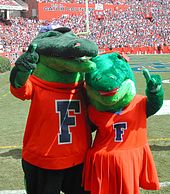 Albert and Alberta Gator, the mascots of the University of Florida; the school chose the alligator as mascot 75 years before the state of Florida named it as official state reptile.
Albert and Alberta Gator, the mascots of the University of Florida; the school chose the alligator as mascot 75 years before the state of Florida named it as official state reptile.
The American alligator is the official state reptile of three states: Florida, Louisiana, and Mississippi. In addition, the Gators have titled the University of Florida's teams since 1911. In that year, a printer made a spur-of-the-moment decision to print an alligator emblem on a shipment of the schools football pennants; the mascot stuck, perhaps because the team captain's nickname was Gator.[30]
See also
- Alligatoridae
- Alligator (film), a movie about a giant alligator living in the sewer of an Illinois town
- Wally Gator, a cartoon about an anthropomorphic alligator
- Everglades
- The Alligator People
- Gatorland
- Brazos Bend State Park
Notes
- ^ Crocodile Specialist Group (1996). Alligator mississippiensis. In: IUCN 2008. IUCN Red List of Threatened Species. Downloaded on 24 February 2009.
- ^ Profile (2011).
- ^ "Crocodilian Species—American Alligator (Alligator mississippiensis)". Flmnh.ufl.edu. http://www.flmnh.ufl.edu/cnhc/csp_amis.htm. Retrieved 2008-10-14.
- ^ Woodward, Allan R.; White, John H.; Linda, Stephen B. (1995). "Maximum Size of the Alligator (Alligator mississippiensis)". Journal of Herpetology 29 (4): 507–513. doi:10.2307/1564733. JSTOR 1564733.
- ^ http://nationalzoo.si.edu/Anis highmals/ReptilesAmphibians/Facts/FactSheets/Americanalligator.cfm
- ^ [1] (2011).
- ^ http://www.thebigzoo.com/Animals/American_Alligator.asp
- ^ http://www.jacksonzoo.org/animals/documents/RAmericanAlligator.doc
- ^ http://animals.nationalgeographic.com/animals/reptiles/american-alligator/
- ^ "Salt Grass Flats—American Alligator". Saltgrassflats.com. http://www.saltgrassflats.com/wildlife/alligator.html. Retrieved 2008-12-02.
- ^ Erickson, Gregory M.; Lappin, A. Kristopher; Vliet, Kent A. (2003). "The ontogeny of bite-force performance in American alligator (Alligator mississippiensis)" (PDF). Journal of Zoology 260 (3): 317–327. doi:10.1017/S0952836903003819. http://www.alligatorfarm.us/images/Research/Erickson%20et%20al.%202003.pdf.
- ^ "White albino alligators". .softpedia.com. http://news.softpedia.com/news/White-albino-alligators-54575.shtml. Retrieved 2008-10-27.
- ^ "American Alligator". Uga.edu. http://www.uga.edu/srelherp/alligators/allmis.htm. Retrieved 2008-12-02.
- ^ a b c Guggisberg, C.A.W. (1972). Crocodiles: Their Natural History, Folklore, and Conservation. Newton Abbot: David & Charles. p. 195. ISBN 0-7153-5272-5.
- ^ Lance, Valentine A. (2003). "Alligator physiology and life history: the importance of temperature". Experimental Gerontology 38 (7): 801–805. doi:10.1016/S0531-5565(03)00112-8.
- ^ "American Alligator". Sciencedaily.com. http://www.sciencedaily.com/articles/a/american_alligator.htm. Retrieved 2008-10-14.
- ^ Dinets, V.L. (2011). "On terrestrial hunting in crocodilians". Herpetological Bulletin 114: 15–18.
- ^ BBC - The Truth about Killer Dinosaurs
- ^ Garrick, L.D. and Lang, J.W. (1977). "Social Displays of the American Alligator". American Zoologist 17: 225–239.
- ^ Dinets, V.L. (2010). "Nocturnal behavior of the American Alligator (Alligator mississippiensis) in the wild during the mating season". Herpetological Bulletin 111: 4–11.
- ^ "Animal Planet :: Australia Zoo—American Alligator". Animal.discovery.com. October 13, 2008. http://animal.discovery.com/fansites/crochunter/australiazoo/06amerigator.html. Retrieved 2008-10-14.
- ^ "Alligator Mating (www.macroevolution.net)". http://www.macroevolution.net/alligator-mating.html. Retrieved 2009-10-28.
- ^ Harding, Brett E.; Wolf, Barbara C. (2006). "Alligator Attacks in Southwest Florida". Journal of Forensic Sciences 51 (3): 674–677. doi:10.1111/j.1556-4029.2006.00135.x.
- ^ Living with Alligators, Myfwc.com [2] on the Internet Archive
- ^ "A String of Deaths by Gators in Florida". nytimes.com. 2006-05-15. http://www.nytimes.com/2006/05/15/us/15alligator.html. Retrieved 2006-05-15.
- ^ Gator-guzzling python comes to messy end. Published 2005-10-05 by Associated Press. Retrieved 2008-03-11.
- ^ Butler, Rhett A. (2005-10-05 Python explodes after swallowing 6-foot alligator in Florida Everglades. Mongabay.com. Retrieved 2008-03-11.
- ^ United States Department of the Interior, U.S. Geological Survey (2008-02-20). USGS Maps Show Potential Non-Native Python Habitat Along Three U.S. Coasts. www.usgs.gov. Retrieved 2008-03-11.
- ^ "Calories in Alligator, Crocodile". Annecollins.com. http://www.annecollins.com/calories/calories-alligator.htm. Retrieved 2008-12-11.
- ^ "History: 1906–1927, early Gainesville". University of Florida. http://www.ufl.edu/history/1906.html. Retrieved February 13, 2011.
External links
- Crocodilian Online
- Photo exhibit on alligators in Florida; from State Archives of Florida
- U.S. Fishery and Wildlife Service – alligator bellows and hisses
- American Alligator at care-sheet.com (WikiPets)
Extant Crocodilian species Kingdom: Animalia · Phylum: Chordata · Class: Sauropsida · (unranked): Archosauria · Superorder: Crocodylomorpha Family Gavialidae Family Alligatoridae Alligatorinae
(Alligators)American alligator (A. mississippiensis) · Chinese alligator (A. sinensis)Caimaninae
(Caimans)Related articles on alligators, caimans, crocodiles and gharials Topics Human
interactionU.S. Alligator fatalities · Crocodile attacks · Alligator farm · Crocodile tears · Famous crocodiles and alligators · Sewer alligatorGame animals and shooting in North America Game birds Bobwhite Quail · Chukar · Hungarian Partridge · Prairie Chicken · Mourning Dove · Ring-necked pheasant · Ptarmigan · Ruffed Grouse · Sharp-tailed Grouse · Snipe (Common Snipe) · Spruce Grouse · Turkey · WoodcockWaterfowl Black Duck · Canada Goose · Canvasback · Gadwall · Greater Scaup · Lesser Scaup · Mallard · Northern Pintail · Redhead · Ross's Goose · Snow Goose · Wood DuckBig game Bighorn Sheep · Black Bear · Razorback · Brown Bear · Bison (Buffalo) · Caribou · Cougar (Mountain Lion) · Elk · Moose · White-tailed deer · Gray wolf · Mountain goat · Mule Deer · Pronghorn · Muskox · Dall Sheep · Polar BearOther quarry American alligator · Bobcat · Coyote · Fox Squirrel · Gray Fox · Gray Squirrel · Opossum · Rabbit · Raccoon · Red Fox · Snowshoe HareSee also Categories:- IUCN Red List least concern species
- Crocodilians
- Symbols of Florida
- Megafauna of North America
- Endemic fauna of the United States
- Reptiles of the United States
- Alligatoridae
- Cuisine of the Southern United States
- Florida culture
- Fauna of the Southeastern United States
- Louisiana culture
- Mississippi culture
- Animals described in 1802
Wikimedia Foundation. 2010.




